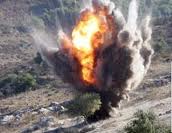
Six Wars on Lebanon still Difficult Number in Conflict

Source: Al-Manar TV, 15-8-2008
During the Nakba (Catastrophe) era in 1948, and while the Zionists were busy committing massacres in the Palestinian village of Deir Kassem and other towns, more "Israeli" soldiers were storming into the Lebanese town of Houla near the border with occupied Palestine, where they killed-massacre 90 inhabitants.
At that time, Lebanon decided to go for truce as its strength, back then, "was in its weakness."
However the armistice never stopped "Israel" from attacking Lebanese towns, whenever it desired.
The result was the massacre of Hanine where residents were executed with axes; Yarine where all the homes were leveled on the heads of their occupants and Aytaroun where seven children were massacred, not to forget the massacres of Bint Jbeil, Rashaya, Kounine, Adloun, Abbasiyeh, Khiam and other villages.
"Israeli" gangs which constituted the kernel of the so called ""Israeli" Army" war closer to aggression than defense. Their massacres continued unabated for the next 20 years.
Most Lebanese still remember "Israel's" bombing of Beirut's International Airport in 1967, when the whole fleet of commercial planes was turned into twisted and riddled metal.
There was no reaction from Beirut, as the whole defeated Arab world plunged in a new era called the "Naksa" or the "Setback.".
In the second half of the 1970's, two years after the civil war broke out, "Israel" entered the phase of organized wars against Lebanon; 6 wars so far.
In 1978, "Israel" exploited the presence of the Palestinian resistance in Lebanon to execute its scheme: Establish a defensive line along the Litani River. The invasion was dubbed "Operation Litani". 30,000 "Israeli" soldiers invaded south Lebanon and formed a 13km - deep "security zone," with the help of then chief collaborator Saad Haddad.
The UN Security Council issued the renowned resolution 425 that stipulates the full "Israeli" withdrawal from Lebanon. "Israel" never implemented the resolution. In its years of occupation, "Israel" committed dozens of massacres in southern villages and towns under the eyes of the international community.
"Israel" launched its second war in 1981. Back then its allies, namely the Phalanges Party, were trapped in the Bekaa city of Zahle by National Forces as well as the Syrian army. The air, land and sea aggression on the western sector of the capital Beirut in particular, left behind 700 people killed and injured. Washington pressed Tel Aviv to accept a ceasefire. However, it violated the truce 2777 times.
Less than a year later, "Israel" launched "Operation Peace of the Galilee." It was nothing more than a barbaric invasion of Lebanon in which 100,000 "Israeli" soldiers, 1100 tanks and 100 fighter jets took part. 25,000 was the count of victims in this third war, not to forget the 1300 Palestinian refugees who were massacred in the Sabra and Shatila refugee camps.
Eventually, "Israel" deemed itself successful after it forced out the Palestinian resistance from Lebanon and imposed a pro-"Israel" regime in Beirut with which it signed a peace deal that was thwarted by national forces. "Israel" woke up to the reality that a new resistance force was on the rise and it was not long before it found itself in a fierce confrontation with it.
A year later, the "Israeli" occupation command had to order a withdrawal under the strikes of the young and inexperienced fighters redeploy, a process that extended until 1985, after at least 1200 "Israeli" soldiers were killed. The new area of occupation was now known as the southern security belt.
In 1985, Hizbullah announced its adaptation of previous resistance operations against the occupation and declared in an "open letter" its decision to resist "Israel" until liberation.
"Israel" and the resistance engaged in a war of attrition with its peak reached in 1993, when Hizbullah retaliated to bombing Lebanese villages resulting in massacres, with bombing the settlement of Kiryat Shmona. "Israel's" response was launching "Operation Accountability."
For seven consecutive days, the Zionist army bombed south Lebanon with no less than 27 thousand shells and another 1000 rocket. 120 Lebanese civilians fell martyrs and a quarter of a million others were displaced. It was "Israel's" fourth war.
Three years later, "Israel's" fifth war was dubbed "Operation Grapes of Wrath," with its main objective: Crush Hizbullah. During 16 days, "Israel" carried out 1100 air raids and fired 25 thousand artillery shells on southern villages as well as Beirut's southern suburb. The toll was 96 civilian martyrs and 165 others injured. In this war, "Israel" separately committed the first Qana massacre and killed another 118 men, women and children taking refuge in a UNIFIL post in the town. 400 houses and stores were completely destroyed and half a million Lebanese were displaced.
The war ended with an understanding known as the "April Understanding" which binds "Israel" not to target civilians.
With the humiliating withdrawal of "Israeli" occupation forces from most Lebanese territory, the Lebanese deemed "Israeli" wars against their country over. But the 2000 pullout dragged a sixth war six years later; a war that far exceeded in violence and barbarism the five preceding wars because "Israel", blessed by the US and some Arab states, wanted it to the last decisive engagement with Hizbullah.
"Israel's" war backlashed and Lebanon became a difficult number in the "Israeli" - Arab conflict.
During the Nakba (Catastrophe) era in 1948, and while the Zionists were busy committing massacres in the Palestinian village of Deir Kassem and other towns, more "Israeli" soldiers were storming into the Lebanese town of Houla near the border with occupied Palestine, where they killed-massacre 90 inhabitants.
At that time, Lebanon decided to go for truce as its strength, back then, "was in its weakness."
However the armistice never stopped "Israel" from attacking Lebanese towns, whenever it desired.
The result was the massacre of Hanine where residents were executed with axes; Yarine where all the homes were leveled on the heads of their occupants and Aytaroun where seven children were massacred, not to forget the massacres of Bint Jbeil, Rashaya, Kounine, Adloun, Abbasiyeh, Khiam and other villages.
"Israeli" gangs which constituted the kernel of the so called ""Israeli" Army" war closer to aggression than defense. Their massacres continued unabated for the next 20 years.
Most Lebanese still remember "Israel's" bombing of Beirut's International Airport in 1967, when the whole fleet of commercial planes was turned into twisted and riddled metal.
There was no reaction from Beirut, as the whole defeated Arab world plunged in a new era called the "Naksa" or the "Setback.".
In the second half of the 1970's, two years after the civil war broke out, "Israel" entered the phase of organized wars against Lebanon; 6 wars so far.
In 1978, "Israel" exploited the presence of the Palestinian resistance in Lebanon to execute its scheme: Establish a defensive line along the Litani River. The invasion was dubbed "Operation Litani". 30,000 "Israeli" soldiers invaded south Lebanon and formed a 13km - deep "security zone," with the help of then chief collaborator Saad Haddad.
The UN Security Council issued the renowned resolution 425 that stipulates the full "Israeli" withdrawal from Lebanon. "Israel" never implemented the resolution. In its years of occupation, "Israel" committed dozens of massacres in southern villages and towns under the eyes of the international community.
"Israel" launched its second war in 1981. Back then its allies, namely the Phalanges Party, were trapped in the Bekaa city of Zahle by National Forces as well as the Syrian army. The air, land and sea aggression on the western sector of the capital Beirut in particular, left behind 700 people killed and injured. Washington pressed Tel Aviv to accept a ceasefire. However, it violated the truce 2777 times.
Less than a year later, "Israel" launched "Operation Peace of the Galilee." It was nothing more than a barbaric invasion of Lebanon in which 100,000 "Israeli" soldiers, 1100 tanks and 100 fighter jets took part. 25,000 was the count of victims in this third war, not to forget the 1300 Palestinian refugees who were massacred in the Sabra and Shatila refugee camps.
Eventually, "Israel" deemed itself successful after it forced out the Palestinian resistance from Lebanon and imposed a pro-"Israel" regime in Beirut with which it signed a peace deal that was thwarted by national forces. "Israel" woke up to the reality that a new resistance force was on the rise and it was not long before it found itself in a fierce confrontation with it.
A year later, the "Israeli" occupation command had to order a withdrawal under the strikes of the young and inexperienced fighters redeploy, a process that extended until 1985, after at least 1200 "Israeli" soldiers were killed. The new area of occupation was now known as the southern security belt.
In 1985, Hizbullah announced its adaptation of previous resistance operations against the occupation and declared in an "open letter" its decision to resist "Israel" until liberation.
"Israel" and the resistance engaged in a war of attrition with its peak reached in 1993, when Hizbullah retaliated to bombing Lebanese villages resulting in massacres, with bombing the settlement of Kiryat Shmona. "Israel's" response was launching "Operation Accountability."
For seven consecutive days, the Zionist army bombed south Lebanon with no less than 27 thousand shells and another 1000 rocket. 120 Lebanese civilians fell martyrs and a quarter of a million others were displaced. It was "Israel's" fourth war.
Three years later, "Israel's" fifth war was dubbed "Operation Grapes of Wrath," with its main objective: Crush Hizbullah. During 16 days, "Israel" carried out 1100 air raids and fired 25 thousand artillery shells on southern villages as well as Beirut's southern suburb. The toll was 96 civilian martyrs and 165 others injured. In this war, "Israel" separately committed the first Qana massacre and killed another 118 men, women and children taking refuge in a UNIFIL post in the town. 400 houses and stores were completely destroyed and half a million Lebanese were displaced.
The war ended with an understanding known as the "April Understanding" which binds "Israel" not to target civilians.
With the humiliating withdrawal of "Israeli" occupation forces from most Lebanese territory, the Lebanese deemed "Israeli" wars against their country over. But the 2000 pullout dragged a sixth war six years later; a war that far exceeded in violence and barbarism the five preceding wars because "Israel", blessed by the US and some Arab states, wanted it to the last decisive engagement with Hizbullah.
"Israel's" war backlashed and Lebanon became a difficult number in the "Israeli" - Arab conflict.


